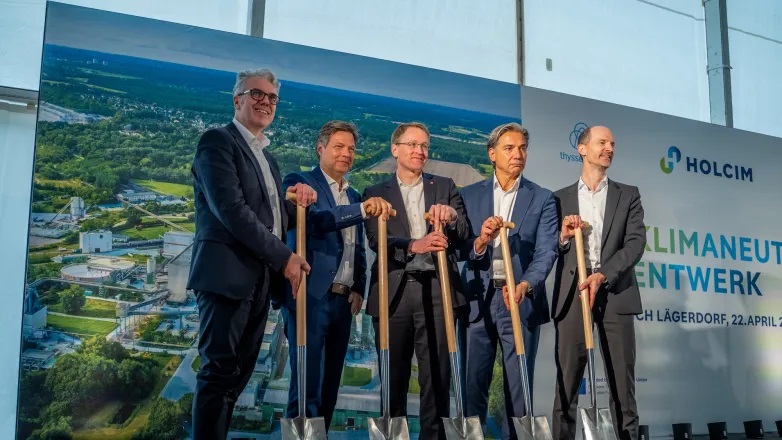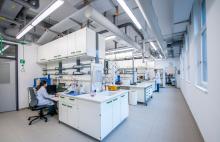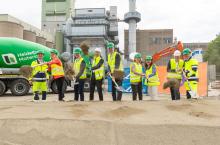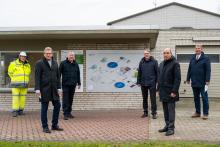
The groundbreaking ceremony was attended by Dr. Robert Habeck, vice chancellor and federal minister for economic affairs and climate protection, Daniel Günther, minister president of Schleswig-Holstein, Thorsten Hahn, CEO of Holcim Germany, Dr. Cetin Nazikkol, member of the executive board of thyssenkrupp Decarbon Technologies, and Andreas Müller, VP Linde Gas Germany.
Holcim says that, by 2028, a cement plant will be built on the Lägerdorf site using new technology to capture CO2 on a large industrial scale, in which the greenhouse gas can be almost completely removed from the exhaust air. The CO2 is then processed for use as a raw material in industry.
To this end, Holcim Germany is building a new kiln line powered by pure oxygen for burning cement clinker and a processing plant for CO2 at the Lägerdorf plant. With this technology, Holcim and the project partners thyssenkrupp Polysius and Linde Engineering say they are advancing CO2 capture on an industrial scale and contributing to the development of a CO2 economy in Germany.
thyssenkrupp is supplying the pure oxyfuel technology, which enables CO2 capture, as part of this lighthouse project.
Hahn said: "Concrete is essential for our cities, factories, houses, bridges and much more. And the energy transition also needs to be built - foundations and towers for wind turbines, routes for rails. With the climate-neutral cement plant, we are ensuring that the building material will continue to be available in the future, but will no longer pollute the atmosphere.
"CO2 emissions are unavoidable in cement production. The majority of the CO2 – around two thirds – is released from the rock itself during burning. These emissions cannot be avoided even by using renewable energies to operate the cement kiln. Hahn: “We are creating sustainable prosperity with this pioneering project. By capturing the CO2 and processing it into a valuable raw material, we protect the climate and enable the creation of new value chains.”
Habeck commented: “The cement industry faces a particularly huge challenge when it comes to decarbonization. The plant here in Lägerdorf demonstrates how it is possible to decarbonize production and boldly implement climate-neutral manufacturing of cement and concrete. The fact that carbon dioxide can not only be captured but also reused as a raw material is a prime example of the green transformation.”
Günther stated: “Today we are launching another innovative German industrial project. The prototype for decarbonization of the cement industry is being built on an industrial scale in Lägerdorf. That shows once again that the future is climate-neutral. And this future begins here in Schleswig-Holstein, the number one state for the energy transition.”
Nazikkol said: “Cement is an indispensable building material. However, cement production is responsible for around seven percent of global carbon emissions. It’s therefore vital to switch to climate-friendly processes. By enriching CO2 by means of the ‘pure oxyfuel’ technology we’ve developed, we help our customers capture almost all of the CO2 arising in the production process and so reuse it in a sustainable manner. Given that annual global cement production is more than four billion tons, we see enormous growth potential for our innovative technology.”
Around 830 kilograms of CO2 per ton of cement are produced in conventional cement manufacturing. In 2019, around 20 million tons of CO2 were released in cement production in Germany alone – which equates to approximately 17 percent of industrial emissions in Germany. The emissions mainly come from production of cement clinker.
The basic principle of the pure oxyfuel technology developed by thyssenkrupp is to separate off CO2 from the exhaust gases of cement factories in a kiln system and thus prevent it from being released into the atmosphere. To enable that, pure oxygen is used in the combustion process instead of ambient air. As a result, almost 100 percent of CO2 emissions from cement clinker production can be captured. The separated process gas is then processed into high-purity CO2 and can subsequently be used as a starting material in the chemical industry or as a raw material in other industries, or alternatively it can be stored. At the new Holcim plant in Lägerdorf, this process will be able to cut CO2 emissions by around 1.2 million tons a year. The plant is scheduled to be commissioned in 2028.
The pure oxyfuel technology has been developed by thyssenkrupp Polysius, one of four business units of thyssenkrupp Decarbon Technologies. In this segment, the Group pools key technologies and services for reducing CO2 for industrial customers. The product portfolio ranges from components and systems for the wind industry, ammonia and ammonia cracking plants, to large-scale water electrolysis technology and solutions for decarbonizing the cement industry.










